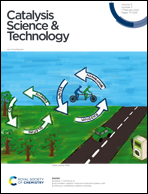Ethane dehydrogenation performance and high temperature stability of silica supported cobalt phosphide nanoparticles†
Abstract
A series of Co–P materials with varying P : Co ratio from 0 to 4 supported on SBA-15 were evaluated for ethane dehydrogenation (EDH) performance. In comparison to monometallic Co, the Co–P materials have improved ethylene selectivity from 41% for Co to 88–90% for Co–P, which was attributed to the segregation of Co atoms and the formation of partial positive Coδ+ sites in the Co–P materials due to charge transfer. Among the Co–P materials studied, an optimum in stability was observed in those containing a P : Co ratio in the range 1 to 2. Below this range, limited P is available to adequately separate Co atoms. Above this range, the excess P promotes coke formation through possible acid catalyzed pathways. The stability of two of the Co–P materials containing the Co2P and CoP phase, respectively, were further tested for EDH at 700 °C. Under these conditions, the ethylene selectivity was 98%, and both materials remained active with little to no deactivation for over 4 h. In comparison to a Pt–Sn reference, both Co–P materials showed vastly improved stability. Additionally, both Co–P materials showed no signs of sintering after EDH at 700 °C and maintained their respective Co2P and CoP phases. These results demonstrate the catalytic improvement with P incorporation and highlights the high stability of Co–P, and possibly other metal phosphides, as high temperature EDH catalysts.



 Please wait while we load your content...
Please wait while we load your content...
